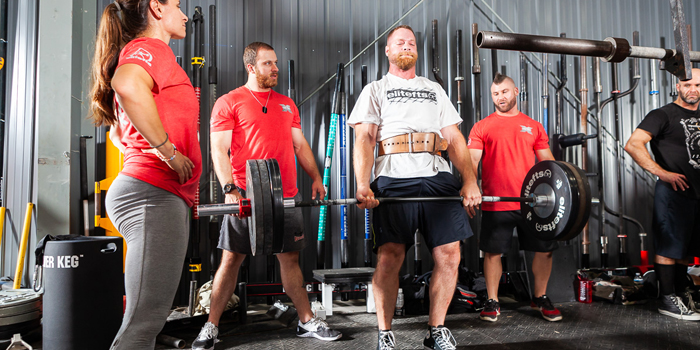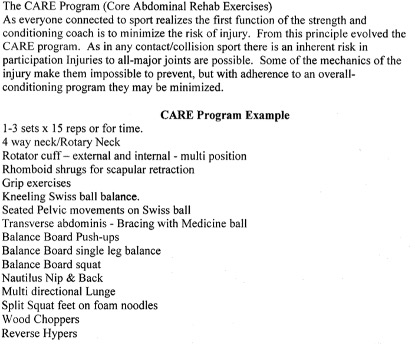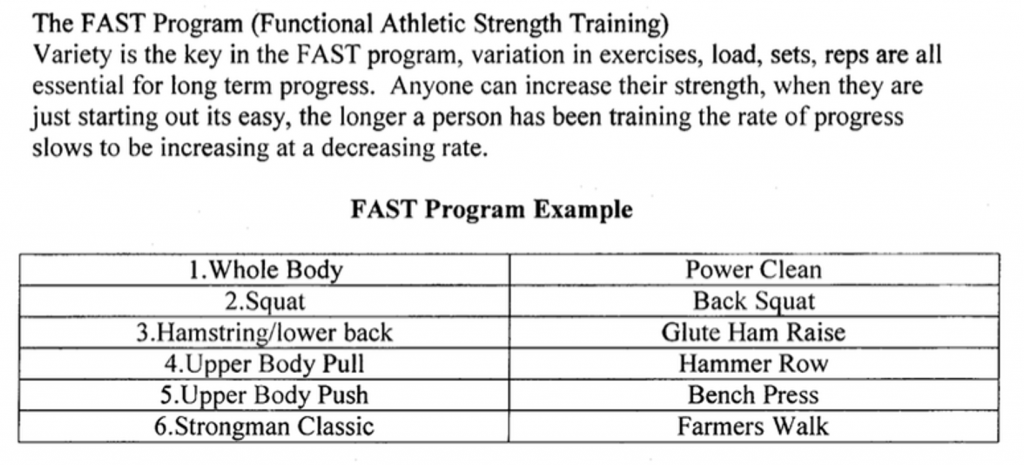
Over the last decade, there has been a plethora of alternative job titles describing the work that we do:
- Strength & Conditioning Coach
- Strength Coach
- Fitness Coach
- Physical Preparation Coach
- Athletic Development Coach
While I am unsure about the reasoning behind the constant need to reframe what we do by a change in job title, our job description has not changed. We have to prepare the individual and the team physically according to how the head coach wants to play the game and minimize the risk of injury to players.
Often we are the scapegoats of an unsuccessful program with head and position coaches claiming, in an attempt to save their jobs, that the team just was not fit enough. After all, as I have written in this column numerous times, no matter how fitter, faster, or stronger we make our players, if the team loses more games than it wins, you will probably be out of a job at the end of the season.
I like how Bryan Mann has phrased the term abilities when he says that "the best ability is availability," and this is where our job starts and finishes, ensuring that players are available for selection on the weekend. All elements of the physical development program must come together to ensure this availability.
RECENT: Programming for a Full Off-Season
It matters not if a player sets a new PR box squat of 300kg. It matters more if a player gets through a productive field session and produces a solid performance on game day. I am not saying that we do not continue to work on elements of the physical program that may be holding a player back but prioritize what a player needs to do to be ready to play. If this means cutting back in the weight to allow an extra skills session, then we must subjugate our egos and allow the player to do that.
It begins in the initial discussions with our head and position coaches to what sort of team, from a physical perspective, do they need to allow the game plan to be pursued. It means more than saying we want them bigger, faster, stronger—any strength and conditioning coach can do this. It means looking at each player, assessing their current strength and work on's, and then prioritizing an individualized program of physical development to allow them to play the game.
It also needs to look at injury history and the positional requirements and stresses that a player will have to withstand to be available each week. This has to be matched with the training age of the player and put into a weekly plan that has recovery elements matched with needs as well. How well are we conditioning the neck in contact sports to ensure we are preparing for collisions and minimizing the risk of concussion? Not just working the traps as a by-product of the Olympic lifts, but training the neck through a range. Are there situations in the sport where players are under great isometric strength and are we paying due diligence to this type of training in the weight room?
I have seen injury prevention training performed at the end of a workout. I have seen it as a separate entity in the day plan and as part of the warm-up for weight training and field sessions. So, there is no correct way to include this. Recently, I was looking through some very old programs that I wrote in the early 1990s. My strength program consisted of two elements. Although now somewhat dated as per exercise selection, the concept remains intact and may well be a starting point to reintroduce into my programming some 25+ years later.

As you can see, this was set up to ensure the key areas of rugby injury prevention were targeted. You will have your own exercises to include. A player would not do everything if it were for a warm-up into a weight session, but if you set it up as a stand-a-lone twice-a-week session, then I think you could easily do something similar in about a 30-minute time slot. I would take the Swiss ball emphasis out. Remember, this was from the early '90s. I would do more loaded core work in this session, calf raises, and nordic drops. I'd consider adding this component taken from the programming of my former strength coach, Marc Keys, where he tri-sets key elements at the end of the program:

Then complete the neck-conditioning plan after this giant/tri-set. Since working with the Iron Neck, I would ensure that I had a few to facilitate the program or try and mandate that each player had their own.
Neck Conditioning Program: Level One
Banded Look Aways 2 x 15 reps each side
Plate Neck Flexion on Bench 2 x 10 reps
Plate Neck Extension on Bench 2 x 10 reps
Suppose you were going to do the specific prehab program before a field session. In that case, you could allocate a strength and conditioning staff member and medical staff to monitor five stations by two minutes each and have a different element at each station. For example:
Station One: Landing and Hopping mechanics
Station Two: Neck bridging or partner range of movement or Iron Neck
Station Three: Shoulder Internal and External rotation with bands
Station Four: Hurdle Hip Mobility
Station Five: Dynamic Mobility movements
(Grasshoppers, Mountain Climbers, Scorpions, Lunge Patterns, etc.)
The second element of my programming from the past was very similar to what it is today.

As you can see, not a lot has changed. I would still have the selection charts to allow individual variation by needs analysis, and I may remove the whole body category for some programs. This program was originally written for an Armed Services rugby squad but could be used in nearly all sports programming today.
To ensure that we are delivering on our job title, irrespective of what we call ourselves, we each need to do the following:
1. Discuss with the head and position coaches what they consider the physical requirements of each position and each player in each position and what needs to be prioritized, from both the physical and skill areas.
2. Discuss these details with each player and get their input into developing their program within the context of the team environment. For me, this is the Holy Grail of team sport training.
3. Discuss these details with the medical staff and get their input and buy-in for what the physical preparation staff is intending to implement and how they can add value and expertise to the program.
4. Develop the plan with your staff and allocate staff members to various roles within the physical development process, as per below:
Lead S&C
- Rugby Integration
- Coach liaison
- Logistical programming/meetings
- Team warm-ups
- Conditioning programming
- Gym Assistance/Coaching
Assistant S&C
- Long-term injured player coordination and implementation
- Intern coordinator
- Strength programming
- Body composition monitoring
Sports Scientist S&C
- GPS
- Sports Science & Monitoring
- Speed programming
- Body composition monitoring
Non-Travelling S&C
- Collects and organizes all S&C
- Supplements travel requirements
- Does non 23 and LTI’s on off days and travel/game days
Intern(s)
- Hydration snd supplementation setup and delivery
- Allocation and collection of HR & GPS monitors
- Collection and recording of RPE’s, weights log data
- Setup of monitoring equipment and recording as necessary
5. Monthly meetings with players to ensure the program is on track or elements need to be changed or trialed differently.
6. Daily and weekly meetings with coaching, medical and physical preparation staff to ensure the programming and planning for each player and the team is on track.
7. Everyone on a team has responsibility for winning.
TEAM FIRST
If the team is successful, then by association, I am successful!
Ashley Jones has worked in three professional sports across 30 years and four continents. He was awarded the NSCA's Professional Coach of the Year in 2016. Ashley holds his CSCS (Certified Strength and Conditioning Specialist) since 1988.











4 Comments